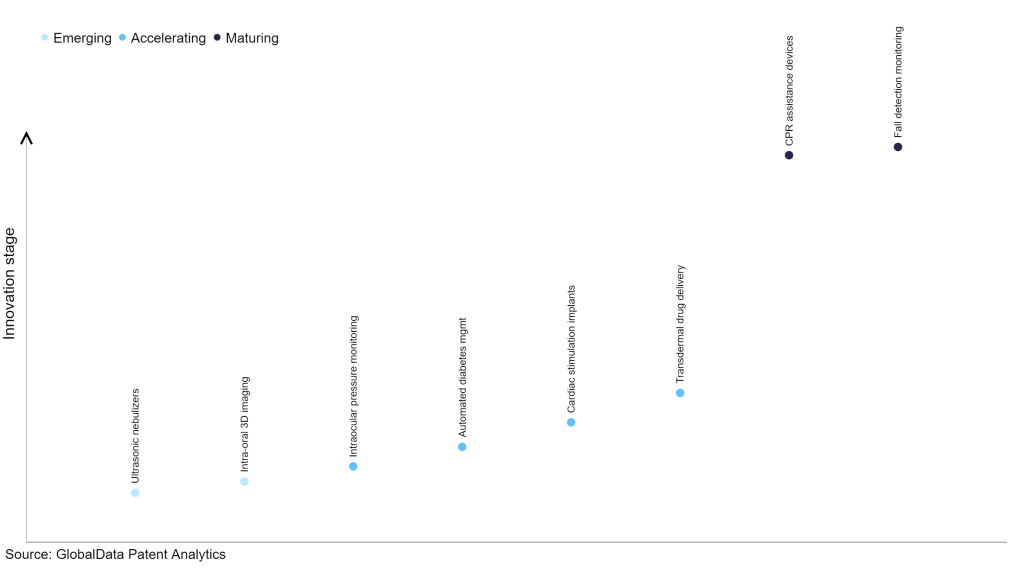The medical devices industry continues to be a hotbed of patent innovation. Activity is driven by increased need for homecare, preventative treatments, early diagnosis, reducing patient recovery times and improving outcomes, and growing importance of technologies such as machine learning, augmented reality, 5G and digitalization. In the last three years alone, there have been over 230,000 patents filed and granted in the medical devices industry, according to GlobalData’s report on Innovation in medical: minimally invasive surgical instruments. Buy the report here.
However, not all innovations are equal and nor do they follow a constant upward trend. Instead, their evolution takes the form of an S-shaped curve that reflects their typical lifecycle from early emergence to accelerating adoption, before finally stabilizing and reaching maturity.
Identifying where a particular innovation is on this journey, especially those that are in the emerging and accelerating stages, is essential for understanding their current level of adoption and the likely future trajectory and impact they will have.
35+ innovations will shape the medical devices industry
According to GlobalData’s Technology Foresights, which plots the S-curve for the medical devices industry using innovation intensity models built on over 165,000 patents, there are 35+ innovation areas that will shape the future of the industry.
Within the emerging innovation stage, ultrasonic nebulizers and intra-oral 3D imaging are disruptive technologies that are in the early stages of application and should be tracked closely. Automated diabetes management, cardiac stimulation implants, and transdermal drug delivery are some of the accelerating innovation areas, where adoption has been steadily increasing. Among maturing innovation areas is CPR assistance devices and fall detection monitoring, which is now well established in the industry.
Innovation S-curve for the medical devices industry

Minimally invasive surgical instruments is a key innovation area in medical devices
Minimally invasive surgical instruments are specialized tools and devices designed to perform surgical procedures through small incisions or natural body openings, minimizing the damage to surrounding tissue and reducing patient recovery time. These instruments include endoscopes, catheters, and other devices that allow surgeons to manipulate and visualize internal organs using advanced imaging and navigation technologies.
GlobalData’s analysis also uncovers the companies at the forefront of each innovation area and assesses the potential reach and impact of their patenting activity across different applications and geographies. According to GlobalData, there are 375+ companies, spanning technology vendors, established medical devices companies, and up-and-coming start-ups engaged in the development and application of minimally invasive surgical instruments.
Key players in minimally invasive surgical instruments – a disruptive innovation in the medical devices industry
‘Application diversity’ measures the number of applications identified for each patent. It broadly splits companies into either ‘niche’ or ‘diversified’ innovators.
‘Geographic reach’ refers to the number of countries each patent is registered in. It reflects the breadth of geographic application intended, ranging from ‘global’ to ‘local’.
Patent volumes related to minimally invasive surgical instruments
Source: GlobalData Patent Analytics
Johnson & Johnson and Medtronic are two of the leading patent filers in minimally invasive surgical instruments. Some other key patent filers include Intuitive Surgical, Abbott Laboratories, and Koninklijke Philips.
In terms of application diversity, Waters leads the pack, while Vektor Medical and Sony Group stood in the second and third positions, respectively. By means of geographic reach, Nuvaira held the top position, followed by Lensar and Carl Zeiss Stiftung.
The future of minimally invasive surgical instruments appears promising with the advancement of robotic-assisted surgery, artificial intelligence (AI)-guided surgery, and imaging technologies. These innovations will enable expert surgeons to operate on patients remotely, offer real-time 3D images that enhance surgical site accuracy and improve results. As healthcare systems continue to focus on reducing costs and improving patient outcomes, minimally invasive surgical instruments are likely to become the preferred choices.
To further understand the key themes and technologies disrupting the medical devices industry, access GlobalData’s latest thematic research report on Medical Devices.
Data Insights
From

The gold standard of business intelligence.
Blending expert knowledge with cutting-edge technology, GlobalData’s unrivalled proprietary data will enable you to decode what’s happening in your market. You can make better informed decisions and gain a future-proof advantage over your competitors.



